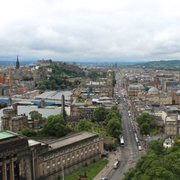David J.
Yelp
The Royal Botanic Garden in Edinburgh is one of the world's oldest, and the second oldest in Britain after Oxford. It is a fabulous place to visit to unwind, and the famous rock garden is sublimely beautiful.
History
Founded originally as a physic garden (to grow medicinal plants) in 1670, it has moved twice; first in 1763 to Leith, and in 1820 to its present location on Inverleith Row. Three additional sites across Scotland have since been added at Benmore (1929), Logan (1969) and Dawyck (1978).
As well as being a major botanic garden with some 15,000 living species, the site at Inverleith Row houses extensive research facilities and a substantial botanical research library, as well as a large herbarium of some 3 million dried specimens.
The garden
The main garden on Inveleith Row also known as 'the Botanics' comprises 70 acres of landscaped gardens and an arboretum, a mile north of the city centre. There are three glasshouses open to the public: the original Tropical Palm House, opened in 1834; the beautiful and impressive Temperate Palm House, opened as an extension in 1862, and 70ft (22m) high; and the striking and large modern glasshouse, opened in the 1960s and, at the time, one of the most innovative designs of its type.
Of the gardens, the top attraction is undoubtedly the famous Rock Garden, which grows alpine plants in a hill-top setting with rocks, an extensive network of paths, a waterfall and a stream. It is beautifully landscaped and, with around 5,000 plant species, regarded by many as the best of its type in the world.
Also impressive is the herbaceous border, which is 165m long and is backed by a beech hedge which is made up of 150 individual trees, now over 100 years old. A newer addition was the Chinese Hillside, created in 1993 and opened formally by Diana, Princess of Wales in 1997. Its collection of 16,000 indigenous Chinese plants is the largest outside China. Finally, reflecting its location, there is a Scottish Heath Garden with a wide range of heathers in a naturalistic setting.
The site also includes a small privately operated art gallery (in Inverleith House).
Practicalities
Entrance is free to the gardens: there is a charge for the glasshouses.
There are entrances on Inverleith Row (East Gate) and Arboretum Row (West Gate). The main public buildings are now contained in the new John Hope Gateway centre by the West Gate. This includes areas for displays and exhibitions, an excellent botanical shop and plant sales area, toilets, a restaurant and information centre.
There is a coffee bar at the East Gate and the Terrace café in the centre of the gardens, which provides excellent views.
Buses 8, 23 and 27 stop close to the East Gate on Inverleith Row. Car parking is limited to metered on-street parking around the site, but there are dedicated disabled parking bays at the John Hope Gateway (West Gate) on Arboretum Place.
All buildings and major areas of the Garden are accessible to wheelchairs. Wheelchairs are available for loan at the Garden entrances and a self-driven electric cart is available by prior appointment. Both the John Hope Gateway and Terrace Café have disabled toilets.
Dogs are not allowed, except for Guide Dogs.















































